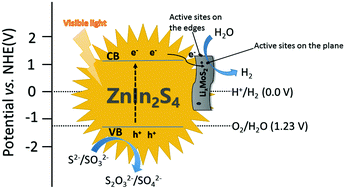当前位置:
X-MOL 学术
›
Catal. Sci. Technol.
›
论文详情
Our official English website, www.x-mol.net, welcomes your
feedback! (Note: you will need to create a separate account there.)
Metallic 1T-LixMoS2 co-catalyst enhanced photocatalytic hydrogen evolution over ZnIn2S4 floriated microspheres under visible light irradiation
Catalysis Science & Technology ( IF 4.4 ) Pub Date : 2018-01-29 00:00:00 , DOI: 10.1039/c7cy02456h Junying Liu 1, 2, 3, 4 , Wenjian Fang 1, 2, 3, 4 , Zhidong Wei 1, 2, 3, 4 , Zhen Qin 1, 2, 3, 4 , Zhi Jiang 1, 2, 3, 4 , Wenfeng Shangguan 1, 2, 3, 4
Catalysis Science & Technology ( IF 4.4 ) Pub Date : 2018-01-29 00:00:00 , DOI: 10.1039/c7cy02456h Junying Liu 1, 2, 3, 4 , Wenjian Fang 1, 2, 3, 4 , Zhidong Wei 1, 2, 3, 4 , Zhen Qin 1, 2, 3, 4 , Zhi Jiang 1, 2, 3, 4 , Wenfeng Shangguan 1, 2, 3, 4
Affiliation

|
Lithium intercalated 1T allotropes of molybdenum disulfide/zinc indium sulfide (1T-LixMoS2/ZnIn2S4) composites were synthesized using a two-step hydrothermal method. The as-prepared samples were characterized using X-ray diffraction, scanning electron microscopy, transmission electron microscopy, X-ray photoelectron spectroscopy, ultraviolet-visible diffuse reflectance absorption spectra, photoluminescence emission spectra and Raman spectra. The results indicate that the lithium intercalation reaction transforms the MoS2 crystal from the hexagonal structure (2H phase) to the trigonal 1T phase. By introducing metallic 1T-LixMoS2 as a co-catalyst, the photocatalytic hydrogen (H2) evolution activity of the ZnIn2S4 microspheres is significantly enhanced under visible light irradiation. The enhanced photocatalytic activity is mainly attributed to the fact that the metallic 1T-LixMoS2 promotes the efficient separation of the photoexcited electrons and the holes of ZnIn2S4 microspheres because of its high electrical conductivity and high densities of the active sites. The photoexcited electrons of ZnIn2S4 microspheres can not only transfer to the edge sites of 1T-LixMoS2, but also to the basal plane active sites of 1T-LixMoS2. Furthermore, the photocatalytic activity is dependent on the content of 1T-LixMoS2 in the composites. The 2.0 wt% 1T-LixMoS2/ZnIn2S4 sample shows the highest H2 production rate of 332.4 μmol h−1, which is 2.4 times higher than that of bare ZnIn2S4 and 1.3 times higher than that of 2.0 wt% 2H-MoS2/ZnIn2S4, and it remains stable even after three photocatalytic cycling tests.
中文翻译:

金属1T-Li x MoS 2助催化剂在可见光照射下在ZnIn 2 S 4多孔微球上 增强光催化氢的释放
采用两步水热法合成了二硫化钼/硫化锌铟(1T-Li x MoS 2 / ZnIn 2 S 4)复合材料的锂插层1T同素异形体。使用X射线衍射,扫描电子显微镜,透射电子显微镜,X射线光电子能谱,紫外可见漫反射吸收光谱,光致发光发射光谱和拉曼光谱来表征所制备的样品。结果表明,锂嵌入反应将MoS 2晶体从六方结构(2H相)转变为三角1T相。通过引入金属1T-Li x MoS 2作为助催化剂,ZnIn 2 S 4微球在可见光照射下的光催化氢(H 2)析出活性显着增强。增强的光催化活性主要归因于金属1T-Li x MoS 2由于其高电导率和高活性位点密度而促进了光激发电子与ZnIn 2 S 4微球空穴的有效分离。ZnIn 2 S 4微球的光激发电子不仅可以转移到1T-Li x MoS 2的边缘位置,但也到1T-Li x MoS 2的基面活动位点。此外,光催化活性取决于复合物中1T-Li x MoS 2的含量。2.0 wt%1T-Li x MoS 2 / ZnIn 2 S 4样品的最高H 2生产率为332.4μmolh -1,是裸ZnIn 2 S 4的2.4倍,是裸ZnIn 2 S 4的1.3倍。 2.0wt%2H-MoS 2 / ZnIn 2 S 4,即使经过三个光催化循环测试,仍保持稳定。
更新日期:2018-01-29
中文翻译:

金属1T-Li x MoS 2助催化剂在可见光照射下在ZnIn 2 S 4多孔微球上 增强光催化氢的释放
采用两步水热法合成了二硫化钼/硫化锌铟(1T-Li x MoS 2 / ZnIn 2 S 4)复合材料的锂插层1T同素异形体。使用X射线衍射,扫描电子显微镜,透射电子显微镜,X射线光电子能谱,紫外可见漫反射吸收光谱,光致发光发射光谱和拉曼光谱来表征所制备的样品。结果表明,锂嵌入反应将MoS 2晶体从六方结构(2H相)转变为三角1T相。通过引入金属1T-Li x MoS 2作为助催化剂,ZnIn 2 S 4微球在可见光照射下的光催化氢(H 2)析出活性显着增强。增强的光催化活性主要归因于金属1T-Li x MoS 2由于其高电导率和高活性位点密度而促进了光激发电子与ZnIn 2 S 4微球空穴的有效分离。ZnIn 2 S 4微球的光激发电子不仅可以转移到1T-Li x MoS 2的边缘位置,但也到1T-Li x MoS 2的基面活动位点。此外,光催化活性取决于复合物中1T-Li x MoS 2的含量。2.0 wt%1T-Li x MoS 2 / ZnIn 2 S 4样品的最高H 2生产率为332.4μmolh -1,是裸ZnIn 2 S 4的2.4倍,是裸ZnIn 2 S 4的1.3倍。 2.0wt%2H-MoS 2 / ZnIn 2 S 4,即使经过三个光催化循环测试,仍保持稳定。











































 京公网安备 11010802027423号
京公网安备 11010802027423号